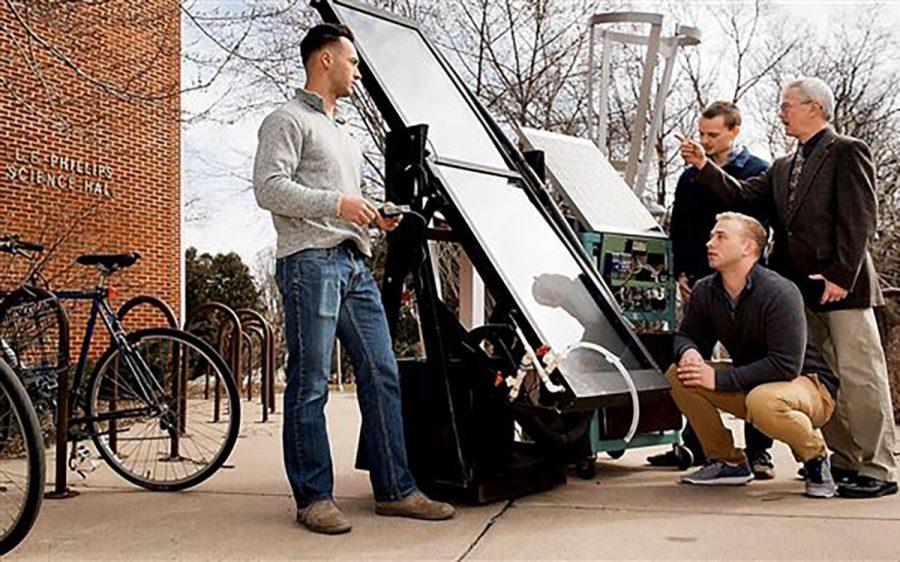UW-Eau Claire students and faculty plans to efficiently use thermal energy heat up
Solar thermal water heater could make sustainable energy readily available to homes and businesses
More stories from Deanna Kolell
Photo by Submitted
From left, students Brendon Kwick, Sawyer Buck and Hunter Hermes, kneeling, and Professor Kim Pierson test their solar-powered water heater.
The Garfield Avenue project is not the only initiative at UW-Eau Claire working to create a more sustainable campus.
Dr. Kim Pierson, a professor of physics and astronomy, along with a team of students, has been dutifully working on developing a solar thermal water heater.
According to a Leader-Telegram article, Pierson made his first model of a solar thermal water heater from cost-effective materials he bought at a local store. He soon saw a potential for building his model at a larger scale.
Pierson aimed to create a solar water heater to preheat water for electric and gas water heaters and provide hot water for ground-source heat pumps. His goal was to make the heater low-cost, lightweight and more efficient than current heating methods.
“Our design is theoretically three times more effective than the solar panels on the roof of Davies Center that provide the energy for hot water in that building,” Pierson told the Leader-Telegram.
Junior Brendan Kwick, who is pursuing a physics degree, as well as a mechanical engineering degree from UW-Madison, said Pierson offered him the opportunity to conduct preliminary research over the summer.
Kwick said he worked with Pierson and Hunter Hermes, a senior applied physics student, and they realized the potential to build a larger model to prove their theoretical findings.
The solar water heater, Kwick said, was designed to be more efficient than other solar-powered thermal panels. Rather than using copper fins, they used a polycarbonate sheet to collect thermal energy.
“The heat only needs to traverse the thickness of the polycarbonate layer. It cuts down on the distance the heat needs to travel by a large amount,” Kwick said. “The lower distance to travel had a larger effect than the lower thermal conductivity of the polycarbonate when compared to copper.”
To get to this point, Kwick said he and his team had to overcome challenges. Collecting data took longer than expected, and the heater itself had some problems. He said the small circulatory pumps often captured air, disabling their ability to pump water. To counter this problem, the team got a larger pump.
Powering all their components was another problem, Kwick said. The team worked to reduce the amount of energy necessary for the heater by consolidating some components.
Despite these setbacks, Hermes said their team has set an ambitious goal for the future of their heater. Eventually, he said they would like to manufacture the heaters and get them on the market.
“It would be great to have our design in real world applications because we believe that it could be more efficient and cheaper than what is on the market now,” Hermes said. “This allows more people … to use this form of green energy which is better for the environment and saves on energy costs.”
Kwick said these solar panels would have practical uses for everyone.
Used with heat pumps, the solar panels could be used to heat homes and portable water. Their solar heaters are less expensive and less intrusive and heat pumps used on ground loops, meaning they can be used with pre-existing homes and businesses.
Both Kwick and Hermes said working with Pierson and other students has helped reinforce the theories they learned in class and teach them to work as a team. Hermes said Pierson allowed students to play a large role in the project.
“Dr. Pierson … always wanted our opinions on what we would do to solve different problems,” Hermes said. “This build confidence in our knowledge and leadership and builds skills that we can transition over to research in a graduate school or to a professional level job.”
In fact, Kwick and Hermes expressed their interest in pursuing a career in sustainable energy.
“I think that green energy is the future for our planet,” Hermes said. “Being a part of it now is going to set the groundwork for generations to come.”

